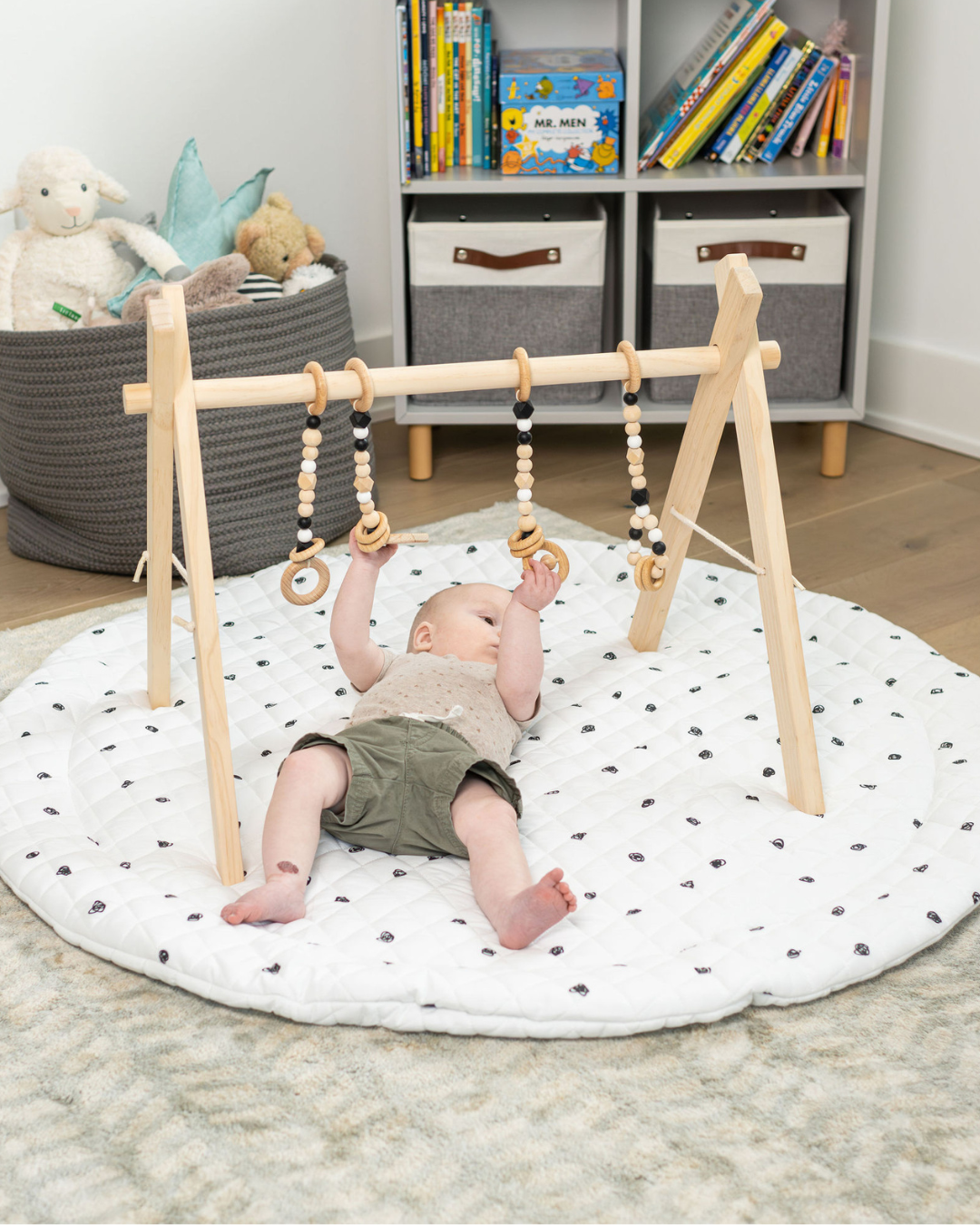Baby Play Gym: A Simple Guide for ParentsBaby Play Gym: A Simple Guide for Parents
Baby Play Gym: A Simple Guide for Parents

A baby play gym is one of the most useful tools for babies in their first year. It helps with learning, movement, and attention, all while giving your little one something fun to do. If you’re wondering what it is and why so many parents use one, this guide provides a clear breakdown.
What Is a Baby Play Gym?
A baby play gym is a padded mat or soft surface with arches that hang toys above the baby. These toys are usually colorful, make sounds, and are safe to touch or grab. Some gyms include mirrors, soft lights, or textures to help babies explore with their senses.
The baby lies on their back or tummy and interacts with the toys by looking, reaching, grabbing, or kicking. It’s a fun way for babies to stay active while learning important skills.
Why Do Parents Choose a Baby Play Gym?
There are a few good reasons why parents add a baby play gym to their must-have list:
Easy setup: Most gyms fold out and are ready to use in minutes.
Safe play: The soft mat provides a clean and padded surface for your baby.
Hands-free time: It gives you a few minutes to rest while your baby stays busy.
The key reason, though, is the developmental value it offers.
What Skills Can Babies Learn?
A baby play gym isn’t just for fun—it’s designed to support early growth. Here’s how it helps:
1. Motor Skills
Grabbing a toy, kicking a hanging rattle, or turning their head to follow a light helps babies practice movement. These little actions improve muscle strength, hand-eye coordination, and control.
2. Sensory Exploration
Many gyms come with toys that crinkle, rattle, or have a unique texture. These textures and sounds stimulate the senses. Babies learn to understand the world by touching and hearing different things.
3. Focus and Attention
Babies are naturally curious. A baby play gym gives them things to look at and listen to, which helps improve focus and attention span.
4. Tummy Time Support
Some gyms include a small pillow or cushion to make tummy time easier. This builds neck and upper body strength, which is important for crawling and sitting later on.
When Should You Start Using One?
Most baby play gyms are made for babies from birth up to around 6–9 months, though some can be used even longer. Here’s a quick guide:
0–2 months: Use for short periods. Your baby may just look around or listen to soft sounds.
3–4 months: Your baby will start reaching for toys, smiling, and reacting to lights or music.
5–6 months: Expect more kicking, grabbing, and even rolling over. They may also enjoy tummy time with more energy.
Always follow the product’s age guide and watch your baby while they play.
Features to Look For in a Baby Play Gym
Not all play gyms are the same. When shopping for one, consider these features:
1. Soft, Washable Mat
Babies can drool, spit up, or have diaper leaks, so a removable and machine-washable mat makes things easier.
2. Adjustable Toy Height
Some gyms let you move toys up or down to keep your baby engaged as they grow.
3. Mirror Panel
Babies love looking at faces, including their own. A mirror panel keeps them busy and supports self-recognition.
4. Music and Lights
Some baby play gyms come with music buttons or soft glowing lights that respond to touch. This adds another layer of learning and fun.
5. Easy to Fold and Store
If you don’t have much space, choose a gym that folds up quickly or can be packed away when not in use.
How Long Should a Baby Use a Play Gym Each Day?
Begin with short sessions, approximately 5 to 10 minutes at a time. You can increase the time as your baby becomes more alert and active. Some babies enjoy several sessions a day, while others prefer shorter playtimes. Let your baby lead the way.
Make sure to mix up positions: some time on the back, some on the tummy, and time sitting with your help. This gives your baby a full-body experience with different types of movement.
Safety Tips to Remember
When using a baby play gym, always keep these safety reminders in mind:
Use it only on flat, clean floors.
Never leave your baby unattended.
Check for loose parts or broken toys.
Stop using it once your baby can sit up without help, unless the gym is made for older babies, too.
Safe play is always better than play that looks fancy but comes with risks.
Can You Use It Every Day?
Yes. A baby play gym can be part of your daily routine. Some parents use it in the morning after feeding, while others place it near where they do chores so the baby stays in sight. Daily play builds habits and gives your baby something to look forward to.
Rotate the toys if possible. Changing the toy positions or swapping in different textures can keep your baby interested without buying a new gym.
Do You Really Need a Baby Play Gym?
While it’s not required, a baby play gym is one of the easiest tools to support learning, motion, and discovery in the first few months. It gives your baby chances to move, look, listen, and interact safely—all in one space.
For busy parents, it’s also a helpful way to provide quality play without needing to carry or entertain your baby all the time. And for babies, it’s a fun and rewarding way to explore the world from their very first months.